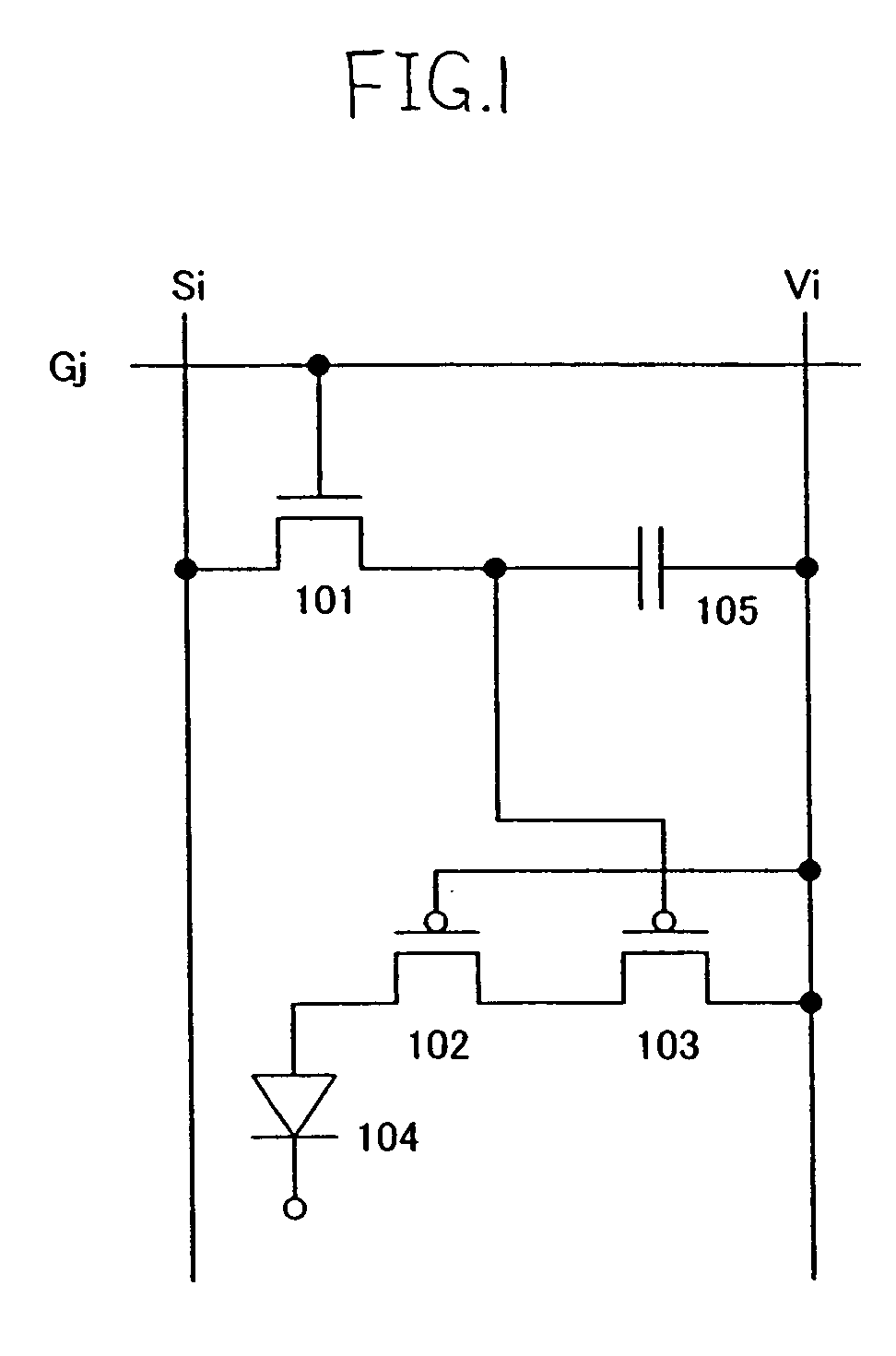Element substrate and light emitting device
a technology of element substrate and light emitting device, which is applied in the direction of static indicating device, instruments, transistors, etc., can solve the problems of affecting the image quality of the device, and the characteristic variation is likely to be increased, so as to enhance the image quality, increase the storage capacity of the capacitor, and reduce the effect of the cause of variation
- Summary
- Abstract
- Description
- Claims
- Application Information
AI Technical Summary
Benefits of technology
Problems solved by technology
Method used
Image
Examples
embodiment mode 1
[0034]FIG. 1 shows an embodiment mode of a pixel of the light emitting device of the invention. The pixel shown in FIG. 1 comprises a light emitting element 104, a transistor (switching transistor) 101 used as a switching element for controlling an input of a video signal to the pixel, a driving transistor 102 for controlling current flowing in the light emitting element 104, and a current controlling transistor 103 for controlling a current supply to the light emitting element 104. In addition, it is also possible to dispose in the pixel a capacitor 105 for storing a potential of a video signal.
[0035]The driving transistor 102 and the current controlling transistor 103 have the same conductivity. It is assumed that the driving transistor 102 is a depletion mode transistor, and the rest of the transistors are normal enhancement mode transistors. In the invention, the driving transistor 102 is operated in a saturation region and the current controlling transistor 103 is operated in a...
embodiment mode 2
[0049]Described in this embodiment mode is a different configuration of a pixel of the light emitting device from that shown in FIG. 1.
[0050]The pixel shown in FIG. 2 comprises a light emitting element 204, a switching transistor 201, a driving transistor 202, a current controlling transistor 203, and a transistor (erasing transistor) 206 for turning OFF the current controlling transistor 203 forcibly. In addition, it is also possible to dispose a capacitor 205 in addition to the aforementioned elements.
[0051]The driving transistor 202 and the current controlling transistor 203 have the same conductivity. The size, characteristics, and operating region of each transistor may be set in the same manner as Embodiment Mode 1.
[0052]The gate of the switching transistor 201 is connected to a first scan line Gaj (j=1 to y). Either the source or drain of the switching transistor 201 is connected to a signal line Si (i=1to x), and the other is connected to the gate of the current controlling ...
embodiment mode 3
[0059]Described in this embodiment mode is a different configuration of a pixel of the light emitting device of the invention from those of Embodiment Modes 1 and 2.
[0060]The pixel shown in FIG. 3 comprises a light emitting element 304, a transistor (switching transistor) 301 used as a switching element for controlling input of a video signal to the pixel, a driving transistor 302 for controlling a current flowing into the light emitting element 304, a current controlling transistor 303 for controlling a current supply to the light emitting element 304. In addition, it is also possible to dispose a capacitor 305 for storing a potential of a video signal as shown in the figure.
[0061]The driving transistor 302 and the current controlling transistor 303 have the same conductivity. The size, characteristics, and operating region of each transistor may be set in the same manner as those of Embodiment Mode 1.
[0062]The gate of the switching transistor 301 is connected to a scan line Gj (j=...
PUM
 Login to View More
Login to View More Abstract
Description
Claims
Application Information
 Login to View More
Login to View More - R&D
- Intellectual Property
- Life Sciences
- Materials
- Tech Scout
- Unparalleled Data Quality
- Higher Quality Content
- 60% Fewer Hallucinations
Browse by: Latest US Patents, China's latest patents, Technical Efficacy Thesaurus, Application Domain, Technology Topic, Popular Technical Reports.
© 2025 PatSnap. All rights reserved.Legal|Privacy policy|Modern Slavery Act Transparency Statement|Sitemap|About US| Contact US: help@patsnap.com



